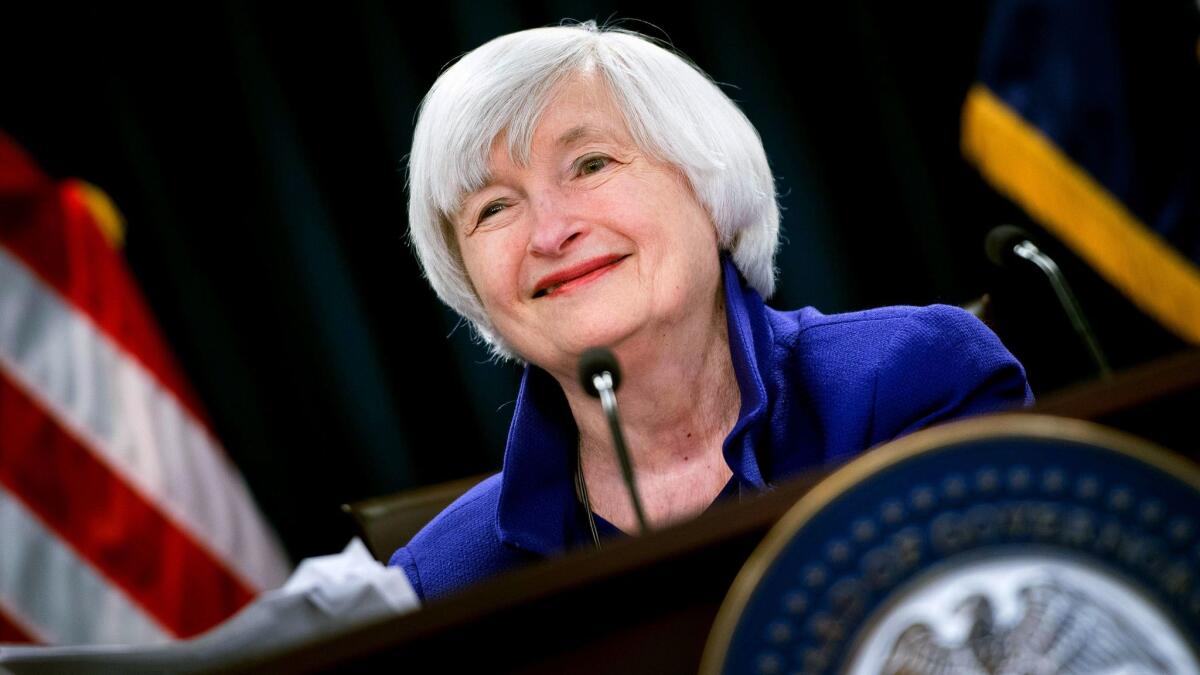Yellen ends her tenure as Federal Reserve chief by paving way for next interest rate hike

- Share via
Reporting from Washington — Federal Reserve officials, meeting for the last time with Janet Yellen as their chief, left borrowing costs unchanged while adding emphasis to their plan for more rate hikes, setting the stage for an increase in March under her successor Jerome Powell.
“The committee expects that economic conditions will evolve in a manner that will warrant further gradual increases in the federal funds rate,” the policy-setting Federal Open Market Committee said in a statement Wednesday in Washington. It added the word “further” twice to previous language.
The changes to the statement, collectively acknowledging stronger growth and more confidence that inflation will rise to the 2% target, may spur speculation that the Fed will pick up the pace of interest-rate increases. Officials also said inflation “is expected to move up this year and to stabilize” around the goal, in phrasing that marked an upgrade from December.
At the same time, the Fed repeated language saying that “near-term risks to the economic outlook appear roughly balanced.”
With her term ending later this week after President Trump chose to replace her, Yellen is handing the reins to Powell, who has backed her gradual approach and is widely expected to raise interest rates at the open market committee’s next meeting for the sixth time since late 2015. Fed officials are hoping to keep a tight labor market from overheating without raising borrowing costs so fast that it would stifle the economy.
“Gains in employment, household spending and business fixed investment have been solid, and the unemployment rate has stayed low,” the Fed said, removing previous references to disruptions from hurricanes. “Market-based measures of inflation compensation have increased in recent months but remain low.”
Missed target
With a gradual pace of rate increases, policymakers want to nudge inflation back up to their 2% target, a goal they have mostly missed for more than five years. Even with a brightening outlook for global growth and Fed tightening, financial conditions continue to ease.
The vote by U.S. central bankers to keep the benchmark overnight lending rate in a 1.25% to 1.5% target range was unanimous. Fed officials also voted to continue with their program to reduce the central bank’s balance sheet, which began in October.
The open market committee said in a separate statement Wednesday that it elected Powell as its chairman, effective Feb. 3. He will be sworn in as chairman of the Board of Governors on Monday.
“On a 12-month basis, both overall inflation and inflation for items other than food and energy have continued to run below 2%,” the FOMC said, removing a previous reference to declines in inflation in 2017.
Inflation has picked up slightly since the middle of 2017 but has remained short of the central bank’s 2% goal. The Fed’s preferred price gauge, a Commerce Department index linked to consumer spending, rose 1.7% in the 12 months through December. Excluding volatile food and energy costs, inflation was 1.5%.
Yellen didn’t hold a news conference after Wednesday’s meeting; her final such event was in December. Fed policy makers will update their economic projections in March, when Powell is also expected to hold his first news briefing as chairman.
New members
An annual rotation among the 12 regional Fed presidents who vote on the FOMC saw Loretta Mester of Cleveland, Thomas Barkin of Richmond, Raphael Bostic of Atlanta and John Williams of San Francisco join as members at this meeting. Barkin and Bostic are voting for the first time since taking their posts.
The committee also reviewed its long-run policy goals statement at the January meeting and reiterated its support for the 2% inflation target, approving a statement that updated the long-run normal rate of unemployment to 4.6% — the median in projections from December.
Several Fed officials have called for a rethink of the central bank’s policy framework, which could include aiming for a higher inflation target or allowing prices to rise faster to make up for the time that they were too low.
During Yellen’s four years at the helm, the U.S. unemployment rate has fallen to 4.1%, the lowest since 2000, as she navigated the Fed away from its crisis-era emergency policies and inched interest rates away from zero. Yellen exploited low inflation to maintain low interest rates that helped pull millions of more Americans back into jobs, and under her leadership the Fed began to pay more attention to labor-market inequality.
“She is going out on a high note,” Diane Swonk, chief economist for Grant Thornton in Chicago, said before Wednesday’s decision.
Powell takes over an economy that expanded at an annualized 2.6% pace in the final three months of the year, helped by stronger business investment and consumer spending. A tax overhaul signed into law by Trump in December is also likely to lift growth in 2018, though the Fed and most analysts see little long-term boost, if any, to the economy.
The Fed statement didn’t contain any reference to the tax legislation.
Torres and Condon write for Bloomberg.
More to Read
Inside the business of entertainment
The Wide Shot brings you news, analysis and insights on everything from streaming wars to production — and what it all means for the future.
You may occasionally receive promotional content from the Los Angeles Times.










